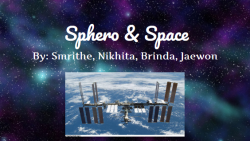Teacher(s) Name: Ms. Fitzpatrick
School: Short Pump ES
Grade Level(s): Grade 4
Content Area(s): English, Math, Science, Children’s Engineering
Lesson Summary
After studying the solar system and computer programming, these fourth grade students began working with the Sphero robot. Once they became aware that the Sphero was going to the International Space Station for a series of experiments, the students wanted to learn more. They contacted representatives from companies involved in the experiments: Sphero, NanoRacks, and DreamUp for more information. The students then researched life on the International Space Station using websites and conversations with a NASA engineer. After doing basic research the students created an essential question: We know that the Sphero was launched from Wallops Island in October 2016 to the International Space Station, what can we design and create for the Sphero to make the lives of the astronauts on the ISS easier? The students divided into two different teams and each one had the same subgroups: researchers, programmers, and research and design. One group focused on the Sphero on land and the other on the Sphero on the ISS or microgravity. One group was communications, the other was public relations. The students worked on projects and reported back to the large group at frequent intervals. Once students had completed their tasks, they all came together to develop a google slide explaining their projects and how they created and designed an adaption that will help the Sphero while in space!
TIPC Ratings
Research & Information Fluency
Rating:Ideal – Explanation: Students had to research a Sphero to learn how it worked, what it’s limitations were and the basics of using the Sphero. Additionally, students had to do some background research on space. It was important they understood how micro-gravity affects movements so that they were better able to design.
Communication & Collaboration
Rating: Ideal – Explanation: Students communicated with representatives from the International Space Station, NASA, and other professionals that assisted them in designing the adaptations necessary for the sphero to be in outer space. Additionally, students worked in many different groups throughout the duration of the project where they were required to work as a team and document their progress.
Critical Thinking & Problem Solving
Rating: Ideal – Explanation: Students were required to think critically and problem solve in each group within this project. The 3D printing groups had to design appropriate adaptations for the Sphero that not only worked, but also fit the Sphero. The Sphero groups had to face challenges as they learned that the Sphero moves differently in water than on land which was essential to understanding the microgravity that would be experienced in space.
Creativity & Innovation
Rating: Ideal – Explanation: Students had to design an appropriate adaptation for the sphero. They used models of various accessories for the sphero to create an original design that best met their needs. Additionally, students documented everything during the project, creating google slide presentations that were shared with their classmates.






